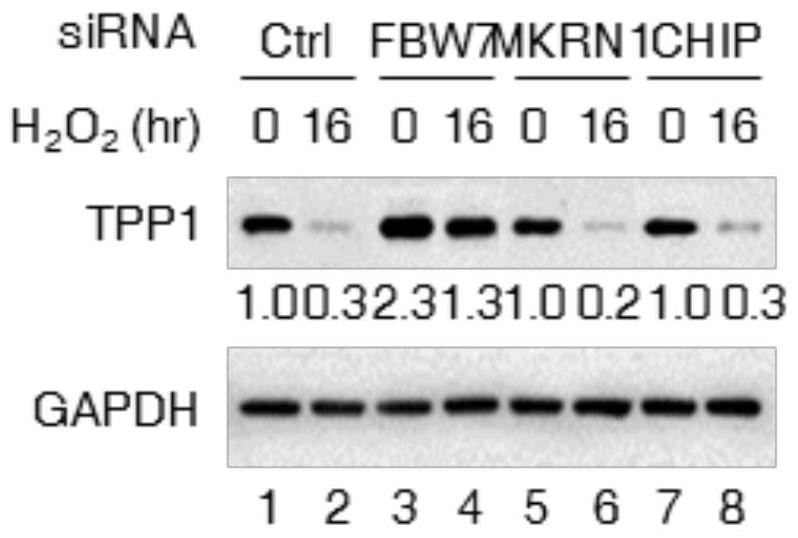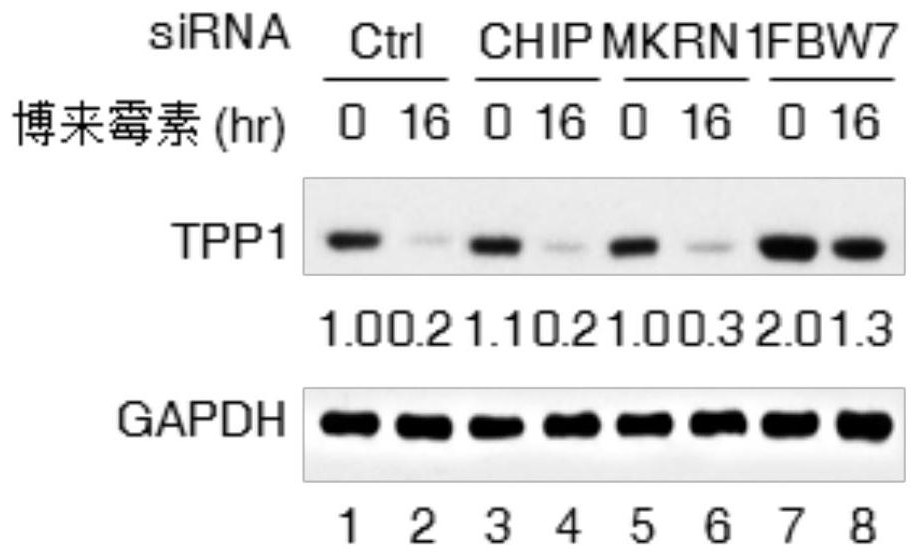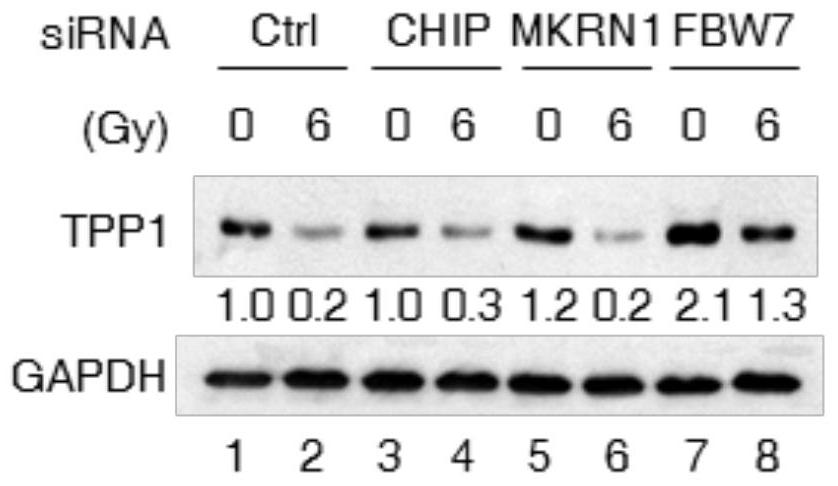Medicinal use of e3 ligase fbw7 in delaying aging and related diseases
A technology of ligase and aging, which is applied in the field of medical application of E3 ligase FBW7 in delaying aging and related diseases, and can solve the problem that the inhibitory effect of FBW7 is not completely clear
- Summary
- Abstract
- Description
- Claims
- Application Information
AI Technical Summary
Problems solved by technology
Method used
Image
Examples
Embodiment 1
[0022] Example 1 Inhibition of the protective effect of FBW7 on telomere-binding protein TPP1 under stress conditions
[0023] Experimental objects: human alveolar basal adenocarcinoma cell A549 and human embryonic kidney cell 293T.
[0024] Experimental method: A549 cells were transfected (transfection reagent was lipofectemin2000) with siRNA against FBW7, MKRN1, CHIP, FBX4, hDM2, RNF8, SIAH2 and control to inhibit their expression, and hydrogen peroxide (100 μM , 16 hours), bleomycin (BLM, 200 μM, 16 hours) and X-ray irradiation (0 Gy and 6 Gy) treatment, using real-time quantitative PCR to detect the interference of FBW7, MKRN1, CHIP, FBX4, hDM2, RNF8 and SIAH2 Efficiency, the expression of TPP1 and internal reference GAPDH was detected by immunoblotting; the plasmids overexpressing FBW7, FBW7γ and TPP1 with HA tag were transfected into 293T cells by lipofectemin2000, and the cells were subjected to CHX after 48 hours of transfection (respectively treated 3, 6 and 9 hours)...
Embodiment 2
[0026] Example 2 Protective effect of inhibiting FBW7 on telomere DNA damage under stress conditions
[0027] Experimental object: human cervical cancer cell Hela.
[0028] Experimental method: Hela cells were transfected with siRNA against FBW7, MKRN1, CHIP, FBX4, hDM2, RNF8, SIAH2 and the control (the transfection reagent was lipofectemin2000) to inhibit their expression, and the cells were given hydrogen peroxide (100 μM and 200μM for 4 hours), bleomycin (BLM, 200μM for 16 hours) and X-ray irradiation (5Gy) treatment, using immunofluorescence (primary antibody is 53BP1) combined with in situ hybridization (Cy3-labeled telomere probe ) (IF-FISH) to detect telomere DNA damage; Hela cells were transfected with siRNA against FBW7 and TPP1, and after 48 hours of transfection, the cells were irradiated with X-rays (0Gy and 5Gy), and then cultured for 1 hour and then used Telomere DNA damage was detected by IF-FISH (supra), and mRNA expression of TPP1 and FBW7 was detected by qua...
Embodiment 3
[0030] Example 3 Effects of FBW7 on telomere length, telomere DNA damage and cell senescence
[0031] Experimental objects: human cervical cancer cells Hela and human fibrosarcoma cells HT1080.
[0032] Experimental method: Transfect Hela or HT1080 cells with plasmids expressing human FBW7α, β and γ subunits, and detect the expression of the three subunits by immunoblotting 48 hours after transfection; detect the opposite ends of the three subunits by chromatin immunoprecipitation The role of telomeric DNA damage; using in situ hybridization and flow combined in situ hybridization (Flow-FISH) to detect the length of telomeric DNA; the cells in the metaphase after the cells were treated with colchicine were detected by FISH. granule signal; use flow cytometry to detect the distribution of cell cycle, and use western blot to detect the expression of senescence-related proteins p16, p53 and p21; use immunofluorescence to detect the expression of HP1γ and p21; use siRNA to transfe...
PUM
 Login to View More
Login to View More Abstract
Description
Claims
Application Information
 Login to View More
Login to View More - R&D
- Intellectual Property
- Life Sciences
- Materials
- Tech Scout
- Unparalleled Data Quality
- Higher Quality Content
- 60% Fewer Hallucinations
Browse by: Latest US Patents, China's latest patents, Technical Efficacy Thesaurus, Application Domain, Technology Topic, Popular Technical Reports.
© 2025 PatSnap. All rights reserved.Legal|Privacy policy|Modern Slavery Act Transparency Statement|Sitemap|About US| Contact US: help@patsnap.com



